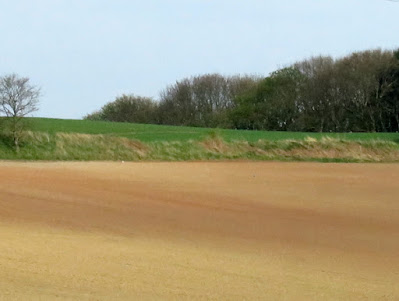As briefly described in my introduction to the geology around the village of Treeton, with walks around Treeton Dyke, the River Rother and 70 Acre Hill, much of the surrounding area has been despoiled by the coal mining industry and I still hadn’t seen any exposures of the underlying strata of the Pennine Middle Coal Measures Formation.
I always try and find something that appeals to my interests in “geology” when I go out on my day trips or - as during the COVID-19 Lockdown in April 2020 - taking essential exercise and my next short walk was to further explore the ridge of Mexborough Rock that I can see from my house.
The lower slopes of the ridge here are covered in landscaped waste from Treeton Colliery, which once occupied the land now covered by the Beaumont Park housing estate and, in memory of the pilot of a Gloster Meteor jet that crashed here in 1954, it has been named Edwards Meteor Way.
The area is very popular with dog walkers and, on the only occasion that I had been there to take some photos of Treeton and views towards Handsworth in the west, a local told me that the waste from Treeton Colliery tipped here constitutes red shale.
Quickly walking to the top, from the entrance at Windle Court, I didn’t see any signs of red shale anywhere and I only stopped to take a good look at the reddened soil that can be seen on the agricultural land beyond.
Wherever the red variety of Mexborough Rock outcrops, its position in the landscape is generally marked by the colour of the soil that lies upon it and, below Burnt Wood, it is very strong. This general colouration of this rock formation and the Spa Fault to the east of is further discussed in the Geological Survey of Britain memoir for the Sheffield region and in a paper by John Hunter in the Mercian Geologist.
I spent less than 15 minutes here and, on this occasion, the light wasn’t very good for photography and so I carried down another path to the Beaumont Estate and, walking along Front Street back to my house, I popped into St. Helen’s churchyard, which I had not visited since the beginning of the lockdown.
To my great surprise, the stonework to the porch was covered in efflorescent salts, which I had never seen before in the 4 years that I had been attending the Coffee Mornings here, when I help with the day to day maintenance of the fabric and the churchyard.
In the late afternoon, with the sun bringing out the colour of the Rotherham Red sandstone and its contrast with the jambs of the doorway, which are built in Ancaster limestone, an interesting example of a weathering process was taking place before my eyes.
The repeated recrystallisation of salts in the micropores of the stone, due to cycles of wetting and drying, causes it to deteriorate and it won’t be that long before the details on the headstops are completely unrecognisable.
Several years ago, I noticed that cavernous decay affected the masonry inside the porch, and having been in effect a ‘surveyor of the fabric’ in recent years, I have noticed that many blocks of stone that exhibit this type of weathering have deteriorated considerably – especially some of the C15 masonry where tool marks have been scoured out.
Finally arriving back on Wood Lane, although I hadn’t seen any exposures of rock or any buzzards, which can often be seen flying around Spa Hill, I was very surprised to see a pheasant wandering along the other side of the road. I have no idea where it might have come from, but it made me smile at the end of the day.













No comments:
Post a Comment